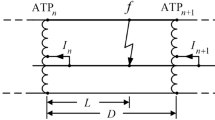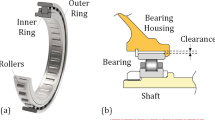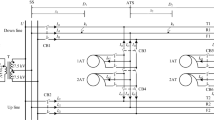Abstract
Due to the fast switching of the commutation cell in a motor drive system, high-frequency electromagnetic disturbances propagate through cables to reach the loads. Mismatched impedances lead to an overvoltage at the loads terminals. In order to study this EMI issue, accurate circuit models of power cables are required. In this context, this paper proposes two multi-conductor cable models. Our approach takes into consideration the frequency dependence of the cable per-unit-length parameters, the coupling between conductors and propagated induced phenomena. The power cables used in motor drive systems are characterized by their rotational symmetry. Thus, the complexity of the model is reduced by means of both a set of mathematical functions approximating the frequency behavior of the cable and using a modal domain-based transfer matrix. So, the VHDL-AMS frequency model can be easily deduced. Once the model is established, the simulation of any cable length becomes an easy task. The model is implemented in ANSYS Simplorer software. After that, the time domain model is built up based on the vector-fitting algorithm. In order to validate our proposal, a comparison of the common mode and the differential mode frequency responses of the reduced cable model with those of the well-known cascaded cell model and measurements found in the literature is performed. The results demonstrate the accuracy and the speed of our approach in the predefined frequency range. Also, a time-domain comparison between the frequency model and the time model is performed. The results obtained validate the two models.




















Similar content being viewed by others
References
Ramachandran R, Nymand M (2017) Experimental demonstration of a 98.8% efficient isolated DC-DC GaN converter. IEEE Trans Ind Electron 64(11):9104–9113
Nguyen-Duc Q, Le Menach Y, Clenet S, Vizireanu DC (2012) Impedance determination in frequency domain for energy cables by FEM and TLM. In: Proceedings of the IX international symposium industrial electronics, INDEL
Marlier C, Videt A, Idir N, Moussa H, Meuret R (2013) Hybrid time-frequency EMI noise sources modeling method. In: 2013 15th European conference on power electronics and applications (EPE), Lille, pp 1–9
Marlier C, Videt A, Idir N, Moussa H, Meuret R (2012) Modeling of switching transients for frequency-domain EMC analysis of power converters. In: 2012 15th international power electronics and motion control conference (EPE/PEMC), Novi Sad, pp 1–8
Krim A, Tahri D, Lakrim A (2018) VHDL-AMS based frequency domain model of four-wire shielded energy cable. In: 2018 19th IEEE mediterranean electrotechnical conference (MELECON), Marrakech, pp 144–148
Marlier C, Videt A, Idir N (2015) NIF-based frequency-domain modeling method of three-wire shielded energy cables for EMC simulation. IEEE Trans Electromagn Compat 57(1):145–155
Bade TG, Roudet J, Guichon JM et al (2019) Frequency-domain modeling of unshielded multiconductor power cables for periodic excitation with new experimental protocol for wide band parameter identification. Electr Eng 101:1–11
Huangfu Y, Di Rienzo L, Wang S (2018) Frequency-dependent multi-conductor transmission line model for shielded power cables considering geometrical dissymmetry. IEEE Trans Magn 54(3):1–4
Stevanović I, Wunsch B, Madonna GL, Skibin S (2014) High-frequency behavioral multiconductor cable modeling for EMI simulations in power electronics. IEEE Trans Ind Inf 10(2):1392–1400
Wunsch B, Stevanović I, Skibin S (2017) Length-scalable multiconductor cable modeling for EMI simulations in power electronics. IEEE Trans Power Electron 32(3):1908–1916
Weens Y, Idir N, Bausiere R, Franchaud JJ (2006) Modeling and simulation of unshielded and shielded energy cables in frequency and time domains. IEEE Trans Magn 42(7):1876–1882
Antonini G, Orlandi A, Pignari SA (2013) Review of Clayton R. Paul studies on multiconductor transmission lines. IEEE Trans Electromagn Compat 55(4):639–647
Wunsch B, Stevanović I, Skibin S (2013) Per-unit-length parameter extraction for lossy multi-conductor power cables. In: IEEE conference on electrical performance of electronic packaging and systems, (EPEPS), San Jose, CA, October 27–30, pp 191–194
Pagnetti A, Xemard A, Paladian F, Nucci CA (2012) An improved method for the calculation of the internal impedances of solid and hollow conductors with the inclusion of proximity effect. IEEE Trans Power Deliv 27(4):2063–2072
Patel UR, Gustavsen B, Triverio P (2013) An equivalent surface current approach for the computation of the series impedance of power cables with inclusion of skin and proximity effects. IEEE Trans Power Deliv 28(4):2474–2482
Patel UR, Triverio P (2016) Skin Effect Modeling in Conductors of Arbitrary Shape Through a Surface Admittance Operator and the Contour Integral Method. IEEE Trans Microw Theory Tech 64(9):2708–2717
Santos VD, Roux N, Revol B, Sareni B, B. Cougo B, Carayon J (2017) Unshielded cable modeling for conducted emissions issues in electrical power drive systems. In: 2017 international symposium on electromagnetic compatibility—EMC EUROPE, Angers, pp 1–6
Paul C (2008) Analysis of multi-conductor transmission line. Wiley, New York
Park Rae-Hong (2002) Comments on “optimal approximation of uniformly rotated images: relationship between Karhumen–Loeve expansion and discrete cosine transform”. IEEE Trans Image Process 11(3):332–334
Krim A, Lakrim A, Tahri D (2020) A passive filtering solution for overvoltage mitigation in doubly fed induction generator-based wind system fed by long power cable. Wind Eng. https://doi.org/10.1177/0309524X20923067
Gustavsen B, Semlyen A (1999) Rational approximation of frequency domain responses by vector fitting. IEEE Trans Power Deliv 14(3):1052–1061
Gustavsen B (2006) Improving the pole relocating properties of vector fitting. IEEE Trans Power Deliv 21(3):1587–1592
Semlyen A, Gustavsen B (2009) A half-size singularity test matrix for fast and reliable passivity assessment of rational models. IEEE Trans Power Deliv 24(1):345–351
Gustavsen B (2008) Fast passivity enforcement for pole-residue models by perturbation of residue matrix eigenvalues. IEEE Trans Power Deliv 23(4):2278–2285
Moreau M (2009) Modélisation haute fréquence des convertisseurs d’énergie. Application à l’étude des émissions conduites vers le réseau, thesis, Université de Lille, France
Weens Y, Idir N, Franchaud JJ (2007) Power cables models with frequency dependent parameters. Int Rev Electr Eng 2(6):763–770
Ametani A (1980) A general formulation of impedance and admittance of cables. IEEE Trans Power Appl Syst 3:902–910
Hafner AA, Caballero PT, Monteiro JHA et al (2017) Modeling of power cables with arbitrary cross section: from parameter calculation to electromagnetic transients simulation. J Control Autom Electr Syst 28:405–417
Ruehli A (1974) Equivalent circuit models for three dimensional multiconductor systems. IEEE Trans Microw Theory Tech 22(3):216–221
Ruehli A, Heeb H (1992) Circuit models for three-dimensional geometries including dielectrics. IEEE Trans Microw Theory Tech 40(7):1507–1516
Yahyaoui W, Pichon L, Duval F (2010) A 3D PEEC method for the prediction of radiated fields from automotive cables. IEEE Trans Magn 46(8):3053–3056
Patel UR, Triverio P (2015) MoM-SO: a complete method for computing the impedance of cable systems including skin proximity, and ground return effects. IEEE Trans Power Deliv 30(5):2110–2118
Patel UR, Triverio P (2016) Accurate impedance calculation for underground and submarine power cables using MoM-SO and a multilayer ground model. IEEE Trans Power Deliv 31(3):1233–1241
Xue H, Ametani A, Mahserediian J, Kocar I (2018) Computation of overhead line/underground cable parameters with improved MoM-SO method. In: 2018 power systems computation conference (PSCC), Dublin, pp 1–7
Habib S, Kordi B (2013) Calculation of multiconductor underground cables high-frequency per-unit-length parameters using electromagnetic modal analysis. IEEE Trans Power Deliv 28:276–284
Gustavsen B, Bruaset A, Bremnes J, Hassel A (2009) A finite element approach for calculating electrical parameters of umbilical cables. IEEE Trans Power Deliv 24(4):2375–2384
Garcia-Sanchez JL et al (2016) Aerial line model for power system electromagnetic transients simulation. IET Gener Transmiss Distrib 10(7):1597–1604
Nahman N, Holt D (1972) Transient analysis of coaxial cables using the skin effect approximation \( A+B\sqrt{s}\). IEEE Trans Circuit Theory 19(5):443–451
Achar R, Nakhla M (2001) Simulation of high-speed interconnects. Proc IEEE 89(5):693–728
Moreno P, Gómez P, Naredo JL, Guardado L (2005) Frequency domain transient analysis of electrical networks including non-linear conditions. Int J Electr Power Energy Syst 27(2):139–146
Gómez P, Uribe FA (2009) The numerical Laplace transform: an accurate technique for analyzing electromagnetic transients on power system devices. Int J Electr Power Energy Syst 31(2):116–123
Bade TG (2019) Characterization of the cabling on industrial power networks for EMI simulation, thesis. Grenoble Alpes
Marlier C (2013) Modélisation des perturbations électromagnétiques dans les convertisseurs statiques pour des applications aéronautiques, thesis, Lille 1
Ametani A, Ohno T, Nagaoka N (2015) Cable system transients: theory, modeling and simulation. Wiley, New York
Author information
Authors and Affiliations
Corresponding author
Additional information
Publisher's Note
Springer Nature remains neutral with regard to jurisdictional claims in published maps and institutional affiliations.
Appendix
Appendix
The entity and the architecture of the three-wire shielded power cable model can be expressed as follows:


Due to the complexity of directly writing all the VHDL-AMS code in the Simplorer software, the authors have developed a MATLAB script that provides the missing part of the code ( see the last comment in the VHDL-AMS code). The complete MATLAB script is written as follows:


The model of four-wire shielded power cables has been implemented similarly and omitted here for concision.
Rights and permissions
About this article
Cite this article
Krim, A., Lakrim, A. & Tahri, D. Two VHDL-AMS-based models of multi-conductor power cables for EMI simulations. Electr Eng 103, 647–661 (2021). https://doi.org/10.1007/s00202-020-01108-1
Received:
Accepted:
Published:
Issue Date:
DOI: https://doi.org/10.1007/s00202-020-01108-1




